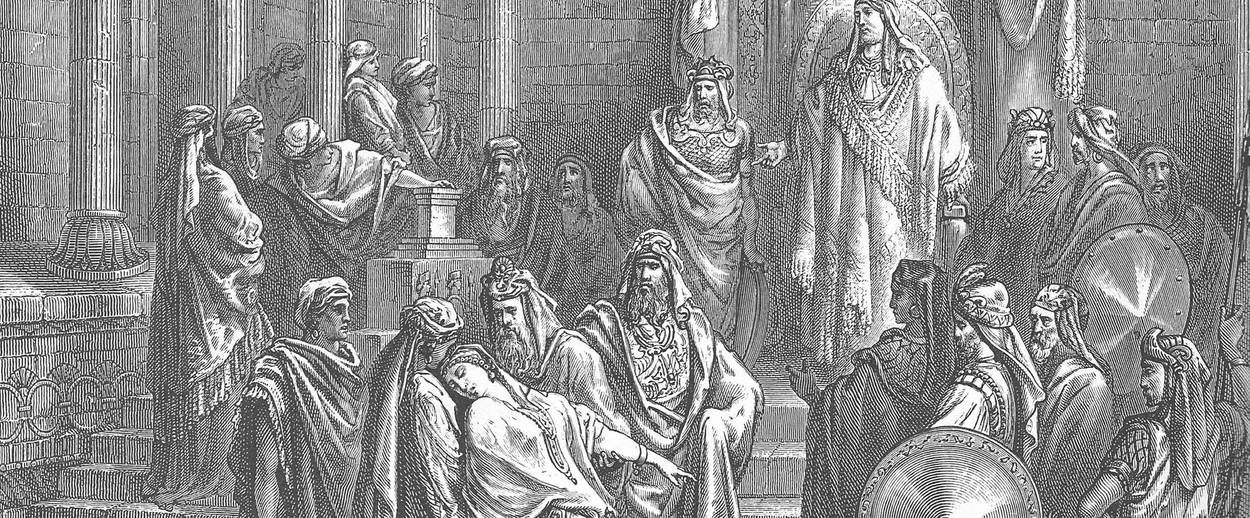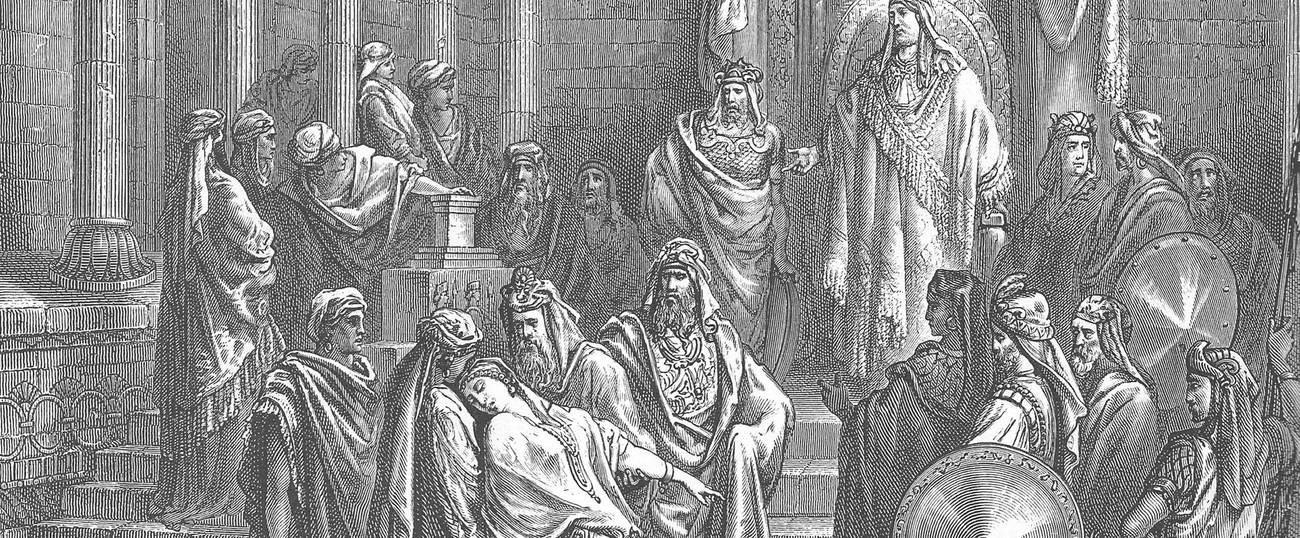The Secret Political History of Queen Esther
From Queen Elizabeth to Abraham Lincoln, the story of Purim has shaped our most contentious debates




Presidential election season in America is heating up in a political environment that feels more polarized than ever. At such a precarious moment, it is valuable to consider the surprising influence upon Western political history of a relatively understudied biblical work: the Book of Esther. In particular, two crucial disputes at moments of great polarization—one during the rise to power of Queen Elizabeth I, the other during the American Civil War—turned upon dueling interpretations of Esther’s story.
Set during the reign of the Persian Emperor Xerxes, the Book of Esther narrates an attempt by Xerxes’ viceroy, Haman, to exterminate the Jewish people. It then records the Jews’ subsequent salvation through the forceful efforts of Xerxes’ Jewish queen, Esther. With the rise of powerful women in the English royal court, political references to the storied Jewish monarch began to proliferate. The reign of Catholic queens in England and Scotland—Mary Tudor, Mary of Guise and Mary Queen of Scots—provoked a vigorous debate over whether or not the Bible sanctioned rule by a woman. The Scottish Protestant writer John Knox, in perhaps the sharpest formulation of the point, regarded such a possibility as “monstrous,” contrary to nature, and offensive to God. Knox’s claim—published on the eve of Elizabeth I’s coronation—proved challenging not merely for Catholics, but for his Protestant colleagues in England as well, who supported the new Protestant monarch. In response, Elizabeth’s allies pointed to Esther as a model. They argued, specifically, that God had historically appointed women like Esther to leadership positions in order to effect the salvation of His people. One pro-Elizabeth writer, John Aylmer, even explicitly compared Elizabeth’s mother, Anne Boleyn, to the biblical queen. In his telling, just as Esther had saved the Jews from Haman, so had Queen Anne preserved English Protestantism from Catholicism. In the ensuing centuries, both Protestants and Catholics—from England, to France, to Germany—utilized this interpretation of Esther’s story to explore their own persecution at the hands of the other. For these thinkers, Esther’s role was a protective, intercessory one. She was seen as a purely reactive figure, responding to danger by sheltering her threatened compatriots.
But the image of Esther as reactive protector who sought merely to save her people is incongruous with the actual biblical narrative. Esther’s response to Haman’s assault on the Jewish people is not simply to request that her people be spared. Esther demands that the perpetrators be held to account. She has Haman charged and hanged for his crimes. She ensures that the Jews of Persia take up arms against those who sought to kill them. And many other people within the empire, seeing justice done, even ally themselves with their Jewish fellow citizens. Esther’s story is not one of reactive hunkering down, but of confident, assertive action in maintaining a decent society in which injustice would not be tolerated.
But if the Elizabethans overemphasized Esther’s reactive, self-protective posture, the opposite mistake featured at a crucial moment in American history, three centuries later. About a week and a half before issuing a preliminary draft of the Emancipation Proclamation on Sept. 22, 1862, President Abraham Lincoln spent a quiet Saturday morning meeting with prominent abolitionist Rev. William Weston Patton. A few months earlier, at a June cabinet meeting, Lincoln had declared his intention to issue an edict of emancipation. But his worry over the Union’s military prospects, and the accompanying concern over seeming to act from a position of desperation, had so far prevented Lincoln from publishing any such edict. In the hopes of encouraging him in the right direction, Patton met with Lincoln to make the religious case for emancipation. Patton concluded his remarks to the President by comparing him to Queen Esther. Drawing upon Chapter 4 in the Book of Esther, in which her cousin Mordechai exhorts Esther to seize the moment and exercise moral leadership, Patton beseeched Lincoln to recognize the wondrous opportunity presented to him by the Almighty to right an historic wrong: “[we] believe that in Divine Providence you have been called to the Presidency to speak the word of justice and authority which shall free the bondman and save the nation.” As Patton saw it, as soon as Esther was made aware of an injustice, she took action and damn the consequences. He felt Lincoln should do the same, assuring the president: “If the Leader will but utter a trumpet call, the nation will respond with patriotic ardor.”
Patton’s interpretation of Esther as zealous idealist is, like the Elizabethans before him, difficult to square with the Book of Esther itself. According to the biblical narrative, when Mordechai informs Esther of Haman’s murderous intentions, she does not immediately confront the king and demand that he rectify the situation. Instead, she devises a political strategy that takes into consideration Haman’s power and influence in the royal court. Counting on Haman’s growing sense of complacency, Esther waited for a moment of maximal opportunity to make her case before Xerxes. Far from throwing caution to the wind and depending upon a miracle, Esther was a deeply strategic thinker who knew that the arc of history does not bend toward justice of its own accord. It must be bent with human participation.
In the end, it was Lincoln himself who best captured the nuances of the biblical Esther. In his response to Patton’s invocation of the biblical queen, Lincoln replied: “Whatever shall appear to be God’s will I will do.” This is a striking, likely deliberate echo of Esther’s words upon hearing from Mordechai of Haman’s plot: “I will go to the king, though it is against the law; and if I perish, I perish.” Like Esther, Lincoln knew the dire risks his proposed course of action entailed for his people, and nevertheless resolved to do the right thing. But, also like Esther, Lincoln refused to take impulsive action. The president had already determined that he would issue the Emancipation Proclamation months before he met with Patton. He felt, however, that it would take a decisive battlefield triumph by Northern forces to vest his edict with the necessary legitimacy in practice. He therefore kept a draft of the edict in his drawer for the entire summer of 1862, biding his time, waiting for the moment when doing the right thing would not only feel good, but be effective. In this respect, Lincoln embodied the legacy of Queen Esther. And if David Gilmour Blythe’s 1863 painting of Lincoln writing the Emancipation Proclamation—in which Lincoln looks for inspiration to two documents: the Constitution and the Bible—is any guide, perhaps Lincoln knew it, too.
Fast forward another century and a half, and America finds itself girding for a presidential election season at a moment of deep political polarization. As Republicans and Democrats now prepare to do battle for America’s soul—or at least its votes—some will encourage Americans to think only of tribal self-interest, principle be damned. This is the reactive, self-protective politics of the Elizabethan Esther. Others, by contrast, will urge Americans to vote only on principle, without regard for any practical consequences. This is the zealous, idealistic politics of William Patton’s Esther. But as Queen Esther herself exemplified, and as Abraham Lincoln understood best, this is a false choice. A sense of justice for all, and a commitment to sound strategic thinking can and should be allied.
Rabbi Dr. Ari Lamm is the CEO of the Bnai Zion Foundation, and a historian of religion